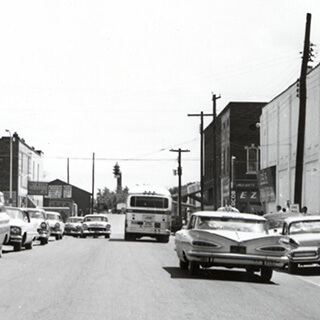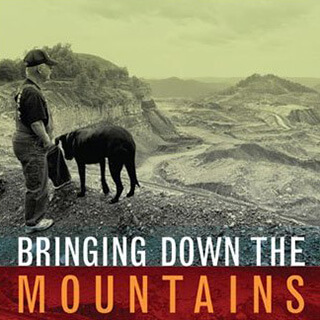Overview
Elena Conis reviews Ellen Griffith Spears's Baptized in PCBs: Race, Pollution, and Justice in an All-American Town (Chapel Hill: University of North Carolina Press, 2014).
Review

In 2001, lifelong Anniston, Alabama, resident Ruth Mims was called to testify in a lawsuit against the multinational corporation Monsanto. Monsanto had owned and operated a chemical manufacturing facility in Anniston since the 1930s, and growing up, Mims and her family—mother, father, and twelve siblings—lived right near the plant. Her parents farmed land near a drainage ditch that carried effluent from the factory. The family's livestock got their water from the ditch, and Mims and her siblings "played barefoot in the dirt and swam and caught tadpoles" in the ditch, whose small currents, as she recalled, were awash with dead minnows (243).
By the time of her testimony, Mims was seventy years old. An expert witness testified that her blood carried "outrageously high" levels of the class of toxic chemicals known as PCBs, manufactured by Monsanto, and that the soil in her yard contained PCB levels "above what the government will consider safe for human habitation" (243). The information should have been no surprise to Monsanto. In her testimony, Mims had recalled how, back in 1970, company representatives had knocked on the family's door, asking to buy their hogs for $25 a head "plus a pint of corn liquor." Unbeknownst to the Mims and their neighbors, Monsanto was collecting nearby livestock to determine the extent of PCB contamination of the local environment and its inhabitants. The company's analyses showed that the chemicals were building up in the animals' fat to levels of roughly 19,000 parts per million (at the time, federal standards advised consuming fish with no more than 5 ppm). But the company kept the results under wraps, even though they clearly pointed to high PCB levels among the poor and working-class families living near the plant.

The concealment of such "toxic knowledge" is a central theme of Ellen Griffith Spears's excellent and important book, Baptized in PCBs: Race, Pollution, and Justice in an All-American Town, which follows the story of Anniston from its factory-town founding in 1872 through its acquisition of the moniker "Toxic Town USA" in 2002. The book reconstructs the history of two "chemical dramas" that played out in Anniston over the century: one concerned the town's battle to clean up PCBs among other chemical pollutants, and the other concerned the fate of chemical weapons stockpiled in Anniston during the Cold War. Spears's book tells a larger story, too, about the intersection of place, racial segregation, class, the military, and pollution. The Mims were an African American family, their plight another instance of a form of southern environmental injustice whose total ramifications have rarely been adequately acknowledged or addressed. In Spears's work, Anniston's story, alongside many other stories of those who, like the Mims, were directly affected by the town's chemical dramas, serves as a powerful "argument for reforming how we manufacture, use, and regulate toxic chemicals in the United States" (xiii). It's an argument, says Spears, that is as urgent as the one made by Rachel Carson in Silent Spring more than half a century ago.

PCBs are industrial chemicals—there are more than two-hundred of them in all—used mostly for their insulating and fire-retardant properties. Anniston was the first site of PCB production in the United States; a company named Swann Chemical set up shop there in the 1920s, drawn to the town's industrial capacity and access to natural resources and cheap labor. As Spears notes, Anniston was founded as an experiment during Reconstruction and by the 1880s had been dubbed a "Model City" of the South for its productive mix of agriculture and industry, fueled by deeply rooted racial hierarchies. By 1930, Swann's Anniston Works produced 3,000 pounds of PCBs daily, shipping exports "as far away as China" (27).

Pollution accompanied this productivity. In the 1930s, Anniston residents complained that dust and smoke from the works was "eating paint" off their cars, houses, and lawn furniture, and some Swann workers sued the company over chemical exposures that made them sick. When Monsanto took over Swann's facility in 1935, the toxic effects of PCBs were well known. Scientific reports detailed the "acneform eruptions" on workers faces and bodies, and studies by a Harvard scientist had found that even "very small amounts of the chemical were harmful" (70, 73). But at this early stage, evidence of "toxic knowledge" was dismissed. Monsanto's physicians blamed the effects on "impurities" and not the chemical itself. When workers became ill, their own physiology was blamed, and they were replaced with "new men" (67).
This refusal and redirection is critical. For Spears's account is, at its core, a simultaneously fascinating and frightening history of the extent of Monsanto's toxic knowledge and the multitude of approaches the company took to control it over time. At times, toxic knowledge was concealed; at other times, it was dismissed. At still other times, Monsanto sought to distract from it, as when the company launched its early public relations campaigns, sponsoring department store displays and Disneyland exhibitions about the achievements of the chemical industry. At other times the company stemmed the flow of toxic knowledge, as when it took advantage of close ties to government officials to procure a promise that the Navy would be "commercially discreet" with information it had accrued about how PCBs sickened not only shipyard workers but also their wives, who were exposed to the chemicals on their husbands' clothes (129).

Historians of health and the environment have documented the importance of chemical "invisibility" to the movement of so-called modern matter,1Mitman, Gregg, Michelle Murphy, and Christopher Sellers, "Introduction: A Cloud Over History," Osiris 19 (2004): 1–20; Murphy, Michelle, Sick Building Syndrome and the Problem of Uncertainty: Environmental Politics, Technoscience, and Women Workers (Durham, NC: Duke University Press, 2006). and as Spears demonstrates, it was relatively easy to "shroud" toxic knowledge about a class of chemicals that was largely invisible to the public, such as PCBs. As chemicals, PCBs are mostly colorless and odorless. Some PCB compounds, visible at first, become colorless when mixed with other chemicals. These properties made PCBs invisible, but so did their applications. PCBs were never sold directly to consumers, but consumers bought and accumulated them unwittingly, since they could be found not only in products ranging from electronics to detergents but in caulk, ink, shoe polish, fabrics, perfumes, and even Christmas trees. PCBs' invisibility made PCB pollution and exposure an issue categorically different from the twentieth-century's most famous chemical drama—DDT pollution and exposure—simply because Americans didn't know when they were buying PCBs, didn't know when and where PCBs were in the environment, and didn't know how to avoid them.
In Baptized in PCBs, the drama turned on two critical historical episodes: one made PCBs ubiquitous; the other helped make them and their toxic effects visible. In wartime, Swann and Monsanto benefited from lucrative federal contracts, forging tight relationships with government agencies that protected the company, its products, and its practices from scrutiny, even as the company grew at an unprecedented rate and its products made their way into every household and every body. In peacetime, new coalitions of activists formed to fight for civil rights, with important consequences for the emergence, decades later, of a form of environmentalism that fought against the injustice of chemical pollution in poor and minority communities. Both of these trends are visible in Anniston's history, demonstrating, as Spears intends, that "local spaces are sites at which global processes take place" (17).
The connection between Anniston's civil rights activism and its environmental activism is an important contribution of Spears's work. But it's also just one piece of the larger narrative she weaves about the historical relationship between race and pollution. When Anniston was founded as a mill town in the late nineteenth century, black workers were given the "dirtiest" jobs and lived on "Smokey Row," within "sight, smell and walking distance of the iron mill" (25). As industry in Anniston changed, patterns of employment and residence remained the same. As a consequence, over a century later African Americans lived on the most PCB-polluted land and had PCB body burdens three times that of whites.

Importantly, however, Spears's point is not that nothing changed. Rather, she shows how, over time, pollution exaggerated—and continues to exaggerate—existing racial disparities. Segregation and poverty exacerbated industrial waste dumping in poor and minority neighborhoods, and in turn, the resulting pollution reinforced and worsened segregation and poverty. As Spears writes, "Segregation had kept African Americans out of city pools, so they swam in (polluted) local swimming holes. Poverty kept supermarkets from locating in the neighborhood, while home gardens exposed residents to contaminated dirt. Relying on small livestock and locally caught fish, promoted decades earlier as a progressive reform . . . ironically made them vulnerable to Monsanto's pollution as well. In circular fashion, being home to a polluting plant depressed neighborhood home values and repelled business development, thereby increasing poverty" (220).
From the hundreds of pounds of PCBs dumped into a local creek on a daily basis in 1969, to the local fish found with 37,800 ppm PCBs, to the fact that Anniston residents today carry among the highest bodily levels of PCBs worldwide for non-workers, there is no shortage of evidence of horrifying pollution practices and consequences in Spears's account. But Baptized in PCBs is not just about PCBs.

During World War II, the Chemical Warfare Service set up a training site near Anniston. By the early 1960s, the Army's entire Chemical-Biological-Radiological Corps Command was moved to Anniston, and the site also became home to a chemical weapons storage site. Only after the US signed the Chemical Weapons Convention of 1993 did Anniston residents come to learn that the local Army depot had been storing more than 2,000 tons of chemical weapons since 1963. In spite of staunch opposition from local citizens, the US Army pursued plans to incinerate the weapons on site—including tons upon tons of deadly nerve agents—defining a series of zones within the town in the process. Residents living within the "Pink Zone" were given protective equipment and training on what to do in case things went wrong and nerve agents escaped during incineration. Spears tells the story of being invited to dinner at the home of a local Anniston family, who offered the caveat that if the incinerator's warning siren went off while Spears was at their house, they had only enough masks to protect themselves—not her.
Anniston residents fought, successfully, for safer Army incineration plans at the same time that legal action against Monsanto was gaining momentum. In 2002, a jury found Monsanto guilty of knowingly poisoning Anniston residents and hiding the dangers of chemical exposures. Over a year later, lawyers for the company and attorneys representing more than 21,000 plaintiffs (including Mims) settled the Anniston PCB cases with a global settlement of $700 million, the "largest award to remedy industrial pollution at a single site in US history" (263).
But this is not necessarily a happy ending, nor is it a conclusion marked by victory. Baptized in PCBs demonstrates the degree to which corporate power has controlled the creation and flow of toxic knowledge. It provides compelling evidence of the extent to which chemical manufacturers took advantage of their products' invisibility, manufactured doubts about their products' toxicity, and nurtured a close relationship with the "machinery of war," a relationship that protected industry at the expense of individuals (7). Anniston's chemical dramas, in Spears's telling, bring into relief the troubling relationships among national security, corporate power, racial hierarchies, and social injustices. They are, as Spears contends, "a paradigmatic case for the need for precaution, for addressing toxic chemical exposures not after the fact but before damage is done" (298). 
About the Author
Elena Conis is assistant professor of history at Emory University, a former award-winning health columnist for the Los Angeles Times, and the author of Vaccine Nation: America's Changing Relationship with Immunization (University of Chicago Press, 2015).
Recommended Resources
Text
Barlett, Donald L. and James B. Steele. "Monsanto's Harvest of Fear." Vanity Fair. May 2008. http://www.vanityfair.com/news/2008/05/monsanto200805.
Grunwald, Michael. "Monsanto Hid Decades of Pollution: PCBs Drenched Ala. Town, But No One Was Ever Told." The Washington Post. January 2002. http://www.commondreams.org/headlines02/0101-02.htm.
Noble, Phillips J. Beyond the Burning Bus: The Civil Rights Revolution in a Southern Town. Montgomery, AL: NewSouth Books, 2013.
Sprayberry, Gary S. "'Town Among the Trees': Paternalism, Class, and Civil Rights in Anniston, Alabama, 1872 to Present." PhD diss., University of Alabama, 2003.
Web
Agency for Toxic Substances and Disease Registry. "Anniston Community Health Survey." http://www.atsdr.cdc.gov/sites/ anniston_community_health_survey/overview.html.
Chemical Industry Archives. "Anniston, Alabama: Pollution, Contamination, Betrayal." http://www.chemicalindustryarchives.org/dirtysecrets/ annistonindepth/intro.asp.
Environmental Working Group. "Anniston Alabama: In-Depth: The Story on Monsanto." http://www.ewg.org/research/anniston-alabama-depth/story-monsanto.
US Environmental Protection Agency. "Region 4: Superfund—Anniston PCB Site." http://www.epa.gov/region4/superfund/sites/npl/alabama/anpcbstal.html.
US Government Printing Office. Senate Hearing 107-637. "PCB Contamination in Anniston, Alabama." http://www.gpo.gov/fdsys/pkg/CHRG-107shrg81528/html/CHRG-107shrg81528.htm.
Film
Robin, Marie-Monique. The World According to Monsanto. YouTube video, 1:48:57. Posted by "wind0wninja2011," April 4. 2011. https://www.youtube.com/watch?v=aK7gAZS0lbY.
Similar Publications
| 1. | Mitman, Gregg, Michelle Murphy, and Christopher Sellers, "Introduction: A Cloud Over History," Osiris 19 (2004): 1–20; Murphy, Michelle, Sick Building Syndrome and the Problem of Uncertainty: Environmental Politics, Technoscience, and Women Workers (Durham, NC: Duke University Press, 2006). |
|---|






